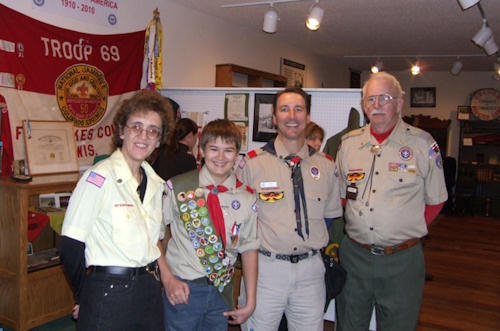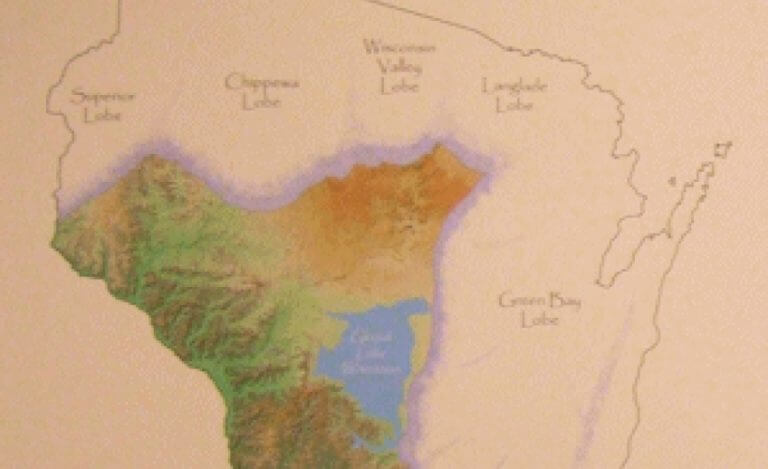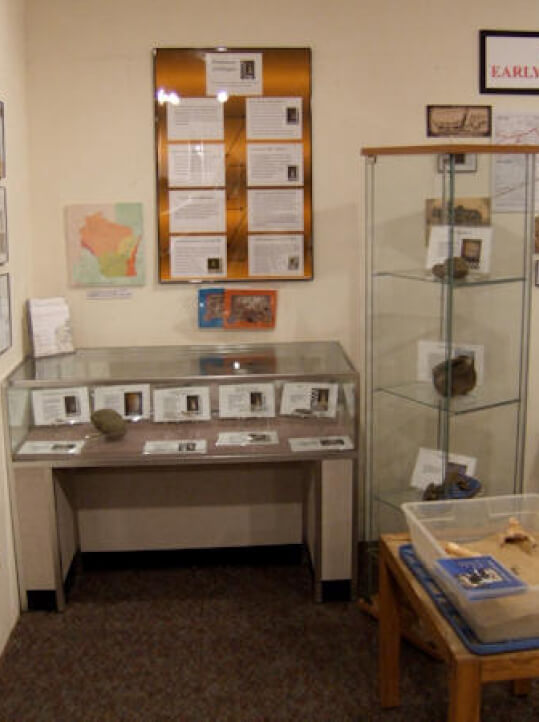
Current Exhibits
- Geo History
- Native American
- Lead Trail
- School Room
- Living Room
Oregon is located in the vicinity of the Johnstown moraine, the terminal moraine from the last major glaciation, which started to retreat about 20,000 years ago. The moraine forms a prominent topographic feature running south and west of Madison, and extends north over the Baraboo Hills and up to Antigo.
When the climate warmed about 15,000 years ago, the glaciers started to retreat, leaving distinctive landforms in part of Dane County.
Geological graphicPollen grains preserved in basins like Hook Lake, near Oregon, and Lakes Wingra, and Mendota record the changes in vegetation that took place as the landscape changed: Sphagnum gave way to sedges and grasses and deciduous forests replaced spruce.
As the glaciers retreated, big game animals like mammoths and mastodons migrated northward. We don’t have any remains of these big animals near Oregon, but they have been found in Wisconsin.

As the glaciers receded, leaving in their wake wet plains and large lakes, Paleo-Indians moved north hunting big game animals and fishing. The big game animals of the time would have included mammoths, mastodons, giant beavers and musk oxen. About 4,000 years ago many of these animals became extinct or moved further north (following the tundra left by the receding glaciers).
The early nomadic groups of Indians were later to be replaced by bands of village dwelling Indians. The Native Indians in our area were the Woodland Indians, the Winnebago, who now use their original name, the Ho Chunk. Early Oregon settlers encountered Indians camped along Badfish Creek and its tributaries.

Under Construction
Under Construction
Under Construction
- Geo History
- Native American
- Lead Trail
- Schools
- Living
Oregon is located in the vicinity of the Johnstown moraine, the terminal moraine from the last major glaciation, which started to retreat about 20,000 years ago. The moraine forms a prominent topographic feature running south and west of Madison, and extends north over the Baraboo Hills and up to Antigo.
When the climate warmed about 15,000 years ago, the glaciers started to retreat, leaving distinctive landforms in part of Dane County.
Geological graphicPollen grains preserved in basins like Hook Lake, near Oregon, and Lakes Wingra, and Mendota record the changes in vegetation that took place as the landscape changed: Sphagnum gave way to sedges and grasses and deciduous forests replaced spruce.
As the glaciers retreated, big game animals like mammoths and mastodons migrated northward. We don’t have any remains of these big animals near Oregon, but they have been found in Wisconsin.

As the glaciers receded, leaving in their wake wet plains and large lakes, Paleo-Indians moved north hunting big game animals and fishing. The big game animals of the time would have included mammoths, mastodons, giant beavers and musk oxen. About 4,000 years ago many of these animals became extinct or moved further north (following the tundra left by the receding glaciers).
The early nomadic groups of Indians were later to be replaced by bands of village dwelling Indians. The Native Indians in our area were the Woodland Indians, the Winnebago, who now use their original name, the Ho Chunk. Early Oregon settlers encountered Indians camped along Badfish Creek and its tributaries.

Featured Displays
Historical Greeting Cards – Changed seasonally. Come see vintage greeting cards and postcards from Oregon’s past.
Children’s toys – perhaps you will remember some of these toys.
Dollhouse Display –
Beauty/barber shop –
Camera Display – Many cameras from 1894 to the 2000s. See how camera’s have changed over the last 100+ years.
Medical Display – Doctors bags and other items used in doctors offices in the early 1900s.
Early Oregon Businesses – large collection of business memorabilia compiled by Ray Lawry.
Farming tools – included is a fanning mill that was used to clean chaff, dirt and other light impurities from grain; a variety of field tools used to hand cut and shock grain; as well as a large variety of tools that the late 19th and early 20th Century farmer would find indispensable for his daily chores. Also included in our farming display is a sleigh with Flo sitting happily ready to visit friends in a cutter/sleigh – how did you travel comfortably in the Wisconsin winter and at the same time keep your feet warm? You may find the answer here.
Dairy – equipment used in times past for the production and processing of dairy products including a cream separator; articles and photos from early Oregon dairies and a machine developed by Professor Babcock of the University of Wisconsin that for the first time accurately tested the butterfat content of a farmer’s milk.
Old-time Kitchen – vintage kitchen items, an old icebox and photos of where the ice came from (cutting ice on Lake Harriet); imagine cooking and baking on a wood cook stove. Just beyond the kitchen is the washroom where you will find a variety of early methods for keeping your clothes clean and in good shape from washboards to wringer washing machines.
Banking exhibit – a variety of forms and equipment from the former Bank of Oregon illustrate what it was like banking prior to today’s automation and computerization.
Military –Oregon residents who served in the Civil War, WWI, WWII, Korean War, Vietnam, the Gulf War, and others. See uniforms and some of the memorabilia from their time in service.
Oregon sports/band – early sports teams, sport’s equipment, and OHS band material.
